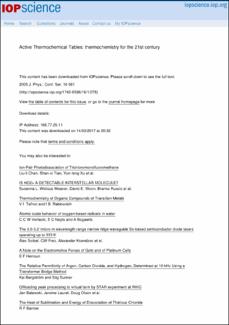Mostrar el registro sencillo del ítem
Active thermo chemical tables: thermochemistry for the 21st century
| dc.contributor.author | Ruscis, Branko | |
| dc.contributor.author | Pinzón, Reinhardt | |
| dc.contributor.author | von Laszewski, Gregor | |
| dc.contributor.author | Kodeboyina, Deepti | |
| dc.contributor.author | Burcat, Alexander | |
| dc.contributor.author | Leahy, David | |
| dc.contributor.author | Montoy, David | |
| dc.contributor.author | Wagner, Albert F | |
| dc.date.accessioned | 2017-08-25T15:50:16Z | |
| dc.date.accessioned | 2017-08-25T15:50:16Z | |
| dc.date.available | 2017-08-25T15:50:16Z | |
| dc.date.available | 2017-08-25T15:50:16Z | |
| dc.date.issued | 2005-12 | |
| dc.date.issued | 2005-12 | |
| dc.identifier.uri | http://ridda2.utp.ac.pa/handle/123456789/2884 | |
| dc.identifier.uri | http://ridda2.utp.ac.pa/handle/123456789/2884 | |
| dc.description | Active Thermochemical Tables (ATcT) are a good example of a significant breakthrough in chemical science that is directly enabled by the US DOE SciDAC initiative. ATcT is a new paradigm of how to obtain accurate, reliable, and internally consistent thermochemistry and overcome the limitations that are intrinsic to the traditional sequential approach to thermochemistry. The availability of high-quality consistent thermochemical values is critical in many areas of chemistry, including the development of realistic predictive models of complex chemical environments such as combustion or the atmosphere, or development and improvement of sophisticated high-fidelity electronic structure computational treatments. As opposed to the traditional sequential evolution of thermochemical values for the chemical species of interest, ATcT utilizes the Thermochemical Network (TN) approach. This approach explicitly exposes the maze of inherent interdependencies normally ignored by the conventional treatment, and allows, inter alia, a statistical analysis of the individual measurements that define the TN. The end result is the extraction of the best possible thermochemistry, based on optimal use of all the currently available knowledge, hence making conventional tabulations of thermochemical values obsolete. Moreover, ATcT offer a number of additional features that are neither present nor possible in the traditional approach. With ATcT, new knowledge can be painlessly propagated through all affected thermochemical values. ATcT also allows hypothesis testing and evaluation, as well as discovery of weak links in the TN. The latter provides pointers to new experimental or theoretical determinations that can most efficiently improve the underlying thermochemical body of knowledge. | en_US |
| dc.description.abstract | Active Thermochemical Tables (ATcT) are a good example of a significant breakthrough in chemical science that is directly enabled by the US DOE SciDAC initiative. ATcT is a new paradigm of how to obtain accurate, reliable, and internally consistent thermochemistry and overcome the limitations that are intrinsic to the traditional sequential approach to thermochemistry. The availability of high-quality consistent thermochemical values is critical in many areas of chemistry, including the development of realistic predictive models of complex chemical environments such as combustion or the atmosphere, or development and improvement of sophisticated high-fidelity electronic structure computational treatments. As opposed to the traditional sequential evolution of thermochemical values for the chemical species of interest, ATcT utilizes the Thermochemical Network (TN) approach. This approach explicitly exposes the maze of inherent interdependencies normally ignored by the conventional treatment, and allows, inter alia, a statistical analysis of the individual measurements that define the TN. The end result is the extraction of the best possible thermochemistry, based on optimal use of all the currently available knowledge, hence making conventional tabulations of thermochemical values obsolete. Moreover, ATcT offer a number of additional features that are neither present nor possible in the traditional approach. With ATcT, new knowledge can be painlessly propagated through all affected thermochemical values. ATcT also allows hypothesis testing and evaluation, as well as discovery of weak links in the TN. The latter provides pointers to new experimental or theoretical determinations that can most efficiently improve the underlying thermochemical body of knowledge. | en_US |
| dc.language | eng | |
| dc.language.iso | eng | en_US |
| dc.rights | https://creativecommons.org/licenses/by-nc-sa/4.0/ | |
| dc.rights | info:eu-repo/semantics/openAccess | |
| dc.subject | active Thermochemical Tables | en_US |
| dc.subject | thermochemistry | en_US |
| dc.subject | Thermochemical Network | en_US |
| dc.subject | active Thermochemical Tables | |
| dc.subject | thermochemistry | |
| dc.subject | Thermochemical Network | |
| dc.title | Active thermo chemical tables: thermochemistry for the 21st century | en_US |
| dc.type | info:eu-repo/semantics/article | |
| dc.type | info:eu-repo/semantics/publishedVersion |
